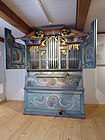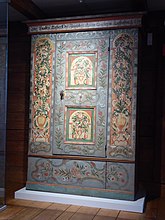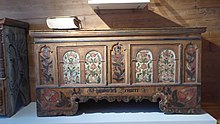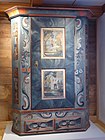Toggenburg furniture painting
The furniture painting is a common throughout Europe rural peasant art. The richest examples of farm furniture painting in Switzerland can be found in Toggenburg and Appenzellerland . Furniture painting flourished in Toggenburg between 1730 and 1850. Rural furniture painting exemplifies the flowing cultural space that existed at that time through connections to Vorarlberg , Tyrol and Bavaria .
Epochs
The first paintings on rustic furniture in Eastern Switzerland are known as early as the 17th century . The spruce wood was mostly painted using simple stencil painting , which was inspired by urban inlay furniture.
Baroque (around 1750 to 1790)
The first known furniture paintings appear in Upper Toggenburg around 1730. Initially, mainly chests (troughs) were painted, as cupboards were still not very popular. The motifs are initially plant-based decorations such as flowers, fruits and tendrils , later animals - especially birds - and people.
The art historian Jost Kirchgraber writes about Toggenburg painting: “It is fascinating, but extremely difficult to prove, whether it was not Pietism that helped to make the world of the Reformed more colorful?”
The pietism was a current that in the 17th century within the Protestantism emerged and fairly wide spread in Toggenburg found.
Rococo (around 1790 to around 1820)
After 1760 the baroque style changed to rococo style , of which there are many and varied examples in Toggenburg peasant painting. Furniture with Prussian blue is numerous . Characteristic are seed beads , box fills with fanciful landscapes and houses as well as ornamental embellishments, especially with floral motifs. In addition to furniture, walls in the houses, house organs and house facades were also painted. Around 1820 the Rococo style changed into the Biedermeier style.
Biedermeier (around 1820 to around 1850)
After the troubled times, the founding of the Canton of St. Gallen in 1803 gave the Toggenburgers reliable structures. A new bourgeoisie established itself in the country. The many newly created factories promoted a sense of family with their regulated working hours. Order and simple modesty became the social yardstick.
After 1820, furniture painters adopted Biedermeier style elements that can be found in Toggenburg until around 1850. The landscapes in the door panels remain imaginative, but the people are represented more concretely, signs of revealing individuality and aspects of secularization .
In peasant circles, after 1800, Senntumsmalerei developed parallel to Biedermeier furniture painting .
painter
The painters were local and only worked within the narrowest region, often within a single village. The various artists never signed their works, but each had his own style. The artists are not known by name from the entire phase of Toggenburg furniture painting, which lasted around a hundred years. They are therefore called emergency names . The similarities in the paintings enable classifications and, for the baroque painters, terms such as the painter of soldiers, the painter of lions with tails of flowers, the painter of beautiful heads, the peony painter , the painter of pious sayings or the painter of scenes for couples .
Peony painter
The peony painter refers to a furniture painter who always used a peony somewhere . The panels of the head of the bed shown show the two seasons of spring and summer in the form of two women. A copper engraving by Rosalba Carriera served as a template .
Painter of pious sayings
No other painter is so dominated by writing as the painter of pious sayings . The writing usually appears framed and stands in front of an ornamentally decorated environment. He paid little attention to the orthographically correct arrangement of the letters.
Painter of the couple scenes
The Toggenburg furniture painters of the Rococo era are just as little known as those of the Baroque. The squirrel painter , the painter of the hunt and the painter of the couple scenes are characteristic.
The main theme of the painter of the couple scenes is the relationship between man and woman. There is always an anemone somewhere in the furniture of the couple painter . More than 100 works by him are known - no Toggenburg furniture painter is assigned more works. The painter of the couple scenes probably had his workshop in Ebnat-Kappel .
The four works are attributed to the painter of the couple scenes :

Motifs

In general, most of the colored Toggenburg cabinets from the 18th century have a three-tier structure. Above you can find the client and the year. An angel's head hovers over many of the doors of Toggenburg cupboards, and towards the end of the century it took on portrait- like features. Pictures of life are placed in the middle. Flowers - tulips mainly because they promise wealth - fruits, birds or people. Toggenburgers were happy to be portrayed with tobacco pipes or swords . In the field under the box door, scenes are played out that deal with the monstrous or death. The most common motif in the lower layer is hunting. But soldiers' armies, mounted junkers and bridges also appear.
The Toggenburg furniture painters often used copperplate engravings as models . They were popular and very common in the 18th century.
After 1750 the color blue became more common. In the 17th century, blue was only widespread among the nobility. After the invention of the chemically produced Prussian blue , the price fell.
Sky tent and sky city were reflected here and there as an image. There are four-poster beds with the undersides painted blue with gold stars on them. Kirchgraber is quoted again on the city of heaven:
- In general, all building was ultimately a shadow of the endeavor to put the new Jerusalem into work, following the rift of the city of heaven (...). Eighteenth-century people were still aware of this.
From the beginning, rural furniture painting had a curious weakness for depicting cities. Although stylistically linked to the Renaissance , rows of arcades have also been a universally understandable symbol of the city since the Middle Ages . The row of arcades on chests and cupboards is not tied to the Renaissance, it also appears in the late 18th century.
Web links
Individual evidence
- ↑ a b Toggenburg furniture painting. Information sign in the Ackerhus Ebnat-Kappel Museum , visited on April 13, 2019
- ^ Hans Büchler: Peasant painting around the Säntis. On: Living Traditions, a website of the Federal Office of Culture . May 31, 2018 (PDF; 0.5 MB)
- ↑ The beginnings of rural furniture painting. Information sign in the Toggenburg Museum Lichtensteig, visited on July 25, 2019
- ↑ a b c The baroque furniture (around 1750 to around 1790). Information sign in the Toggenburg Museum
- ↑ Jost Kirchgraber: The rural Toggenburg house and its culture in the upper Thur and Necker valleys between 1648 and 1798 . VGS Verlagsgenossenschaft, St. Gallen 1990, ISBN 978-3-7291-1056-4 , p. 60-61 .
- ↑ Kirchgraber, p. 60
- ↑ Kirchgraber, pp. 62–63
- ↑ a b The Rococo Furniture (around 1790 to around 1820). Information sign in the Toggenburg Museum
- ^ Biedermeier in Toggenburg. Information sign in the Ackerhus Ebnat-Kappel Museum, visited on April 13, 2019
- ↑ a b The Biedermeier furniture (around 1820 to around 1850). Information sign in the Toggenburg Museum
- ↑ a b c Kirchgraber, p. 79
- ↑ a b The Peony Painter. Information sign in the Ackerhus Museum
- ↑ The painter of the couple scenes. Information sign in the Ackerhus Museum
- ↑ Alpine roses. Information sign in the Ackerhus Museum
- ↑ a b c Kirchgraber, p. 55
- ↑ Kirchgraber, p. 81
- ↑ Kirchgraber, p. 77
- ↑ Kirchgraber, pp. 55–56
- ↑ Kirchgraber, p. 56











